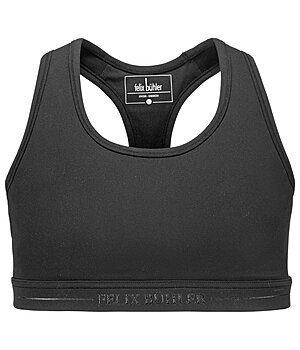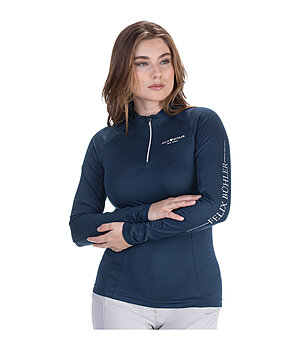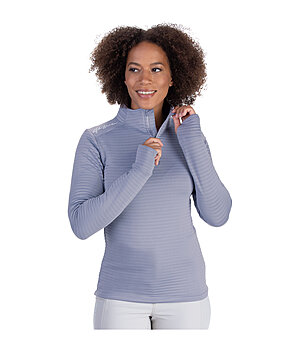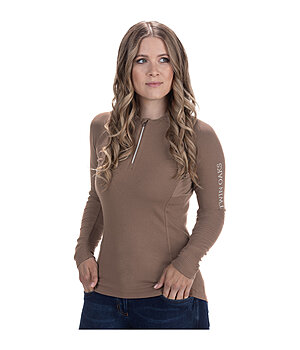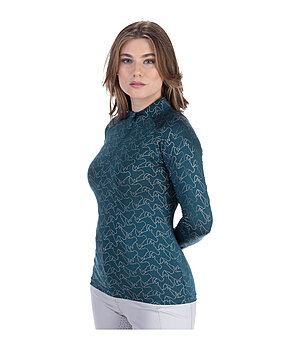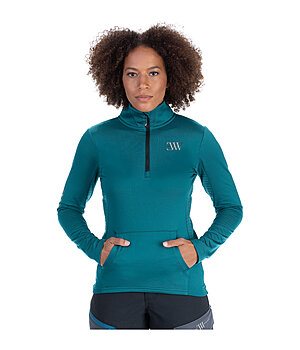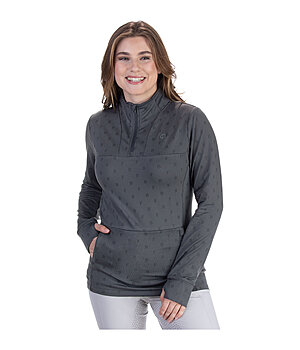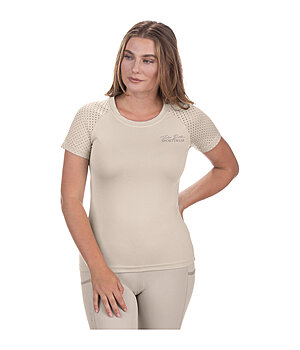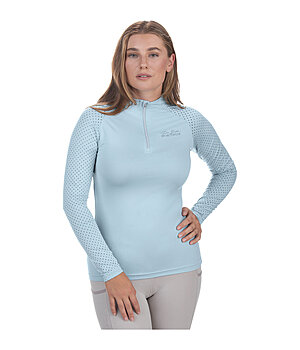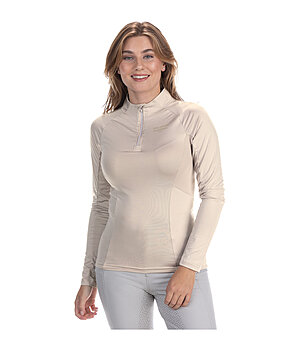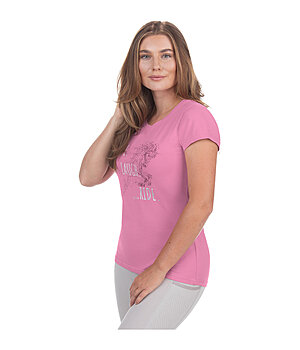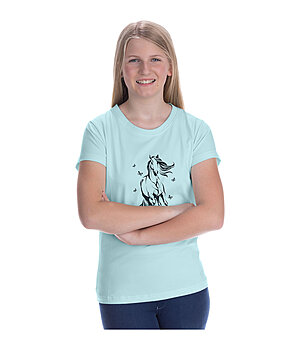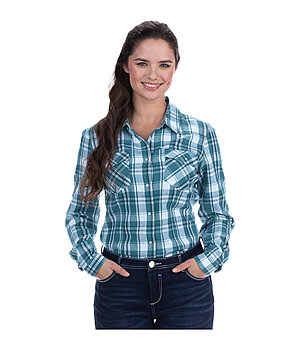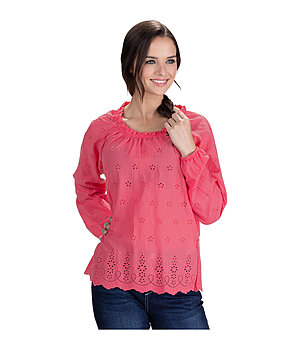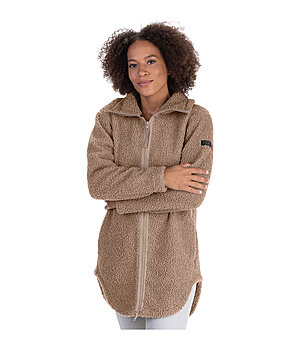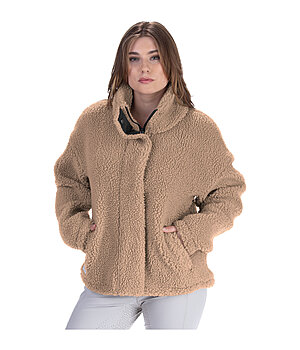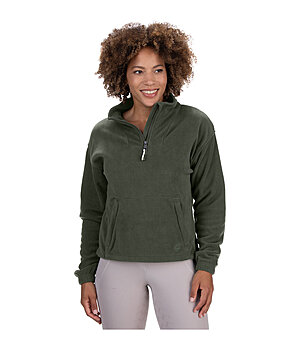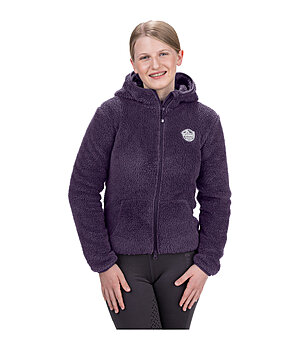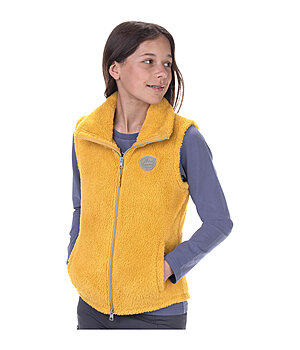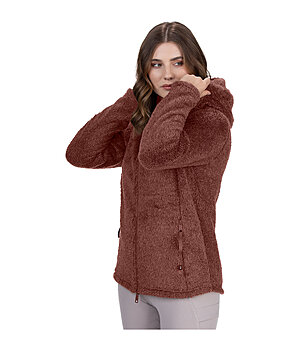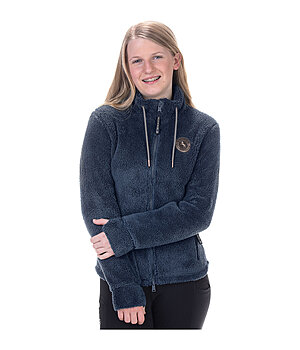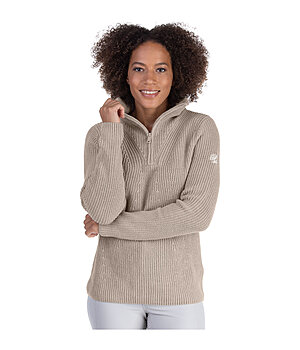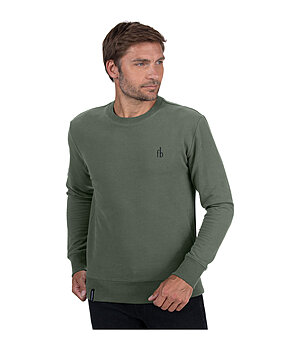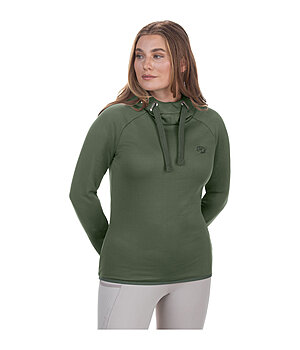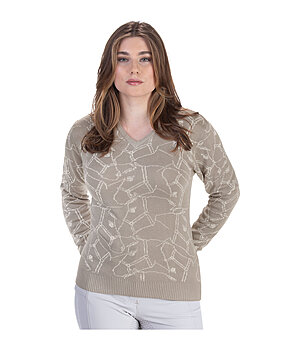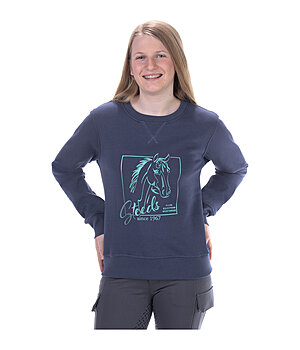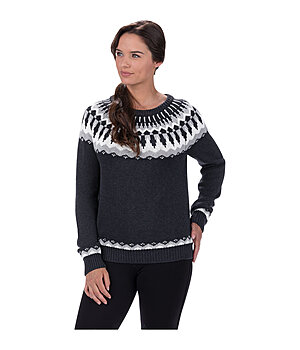Outerwear for riders – from underwear to jumpers
Comfortable riding wear is essential in the saddle and when working at the yard. When it comes to a rider’s well-being, well-fitting breeches alongside a suitable and functional riding outerwear are indispensable components of any riders outfit. Depending on the current weather conditions, individual preferences and riding requirements, it is essential to have the appropriate riding outerwear.

In our guide, we will show you all the different types of riding outerwear and give you an initial overview of which outerwear is best suited to you and your requirements.
Functional underwear for riders
Ill-fitting underwear can be particularly uncomfortable during sporting activities and can even lead to painful chafing and a reduced athletic performance. That’s why you should pay attention to a few details when buying functional underwear, as not all sports underwear is suitable for every type of sport.
What should I look out for in riding underwear?
- Riding is an outdoor sport: Heated indoor arenas are still a rarity and many riders enjoy taking their four-legged friends for long hacks in the countryside. And even when mucking out the stalls in the stable aisle, especially in the colder winter months, the notorious wind chill effect can occur due to a sharp breeze, which intensifies the cold sensation and leads to the loss of body heat if unsuitable clothing is worn. Thermal riding underwear is ideal for cold temperatures to create an optimum base layer providing thermal insulation.
- Riding is a sweat-inducing sport: Breathable functional textiles also ensure that sweat is wicked away from the body and no heat build-up occurs. If the sweat is reliably wicked away to the outside, this also automatically prevents the development of unpleasant odours, as sweat odour is only created when it is broken down into its individual components by the bacteria on the skin. If you want to combat odours even more effectively during sport, functional underwear made from odour-neutralising and anti-bacterial merino wool is a wise choice.

- Riding is a sport that requires a lot of movement, so materials that stretch as much as possible and are kind to the skin are a must for the best wearing comfort – especially when it comes to underwear. Sitting in the saddle can quickly become uncomfortable due to irritating seams. Riding briefs are therefore seamless or have especially flat seams. Female riders should definitely invest in a well-fitting sports bra. The female breast consists mainly of fatty, glandular and connective tissue and therefore requires additional support during intense exercise to prevent tissue damage and chronic pain caused by adopting a relaxed posture.
What should I look out for when buying a sports bra for riding?
According to a study conducted by the University of Memphis with recreational runners, a good sports bra is not only more comfortable to wear, but can also have a significant impact on your own athletic performance. Due to the lack of support provided by a sports bra, the female breasts move up and down by up to four centimetres on average during movement-intensive sports such as horse riding. The body reacts to this with compensatory movements, which can lead to incorrect posture not only when running, but also in other sports such as horse riding, which could result in an increased risk of injury and chronic pain. The focus on the correct rider’s seat and aids could also be lost. It is therefore all the more important to pay attention to the following details when buying a sports bra for riding:
- In order for the sports bra to fulfil its supporting function, it must fit snugly against the body.
- The cup should enclose the breast securely without squeezing.
- The underband or underwires finish under the bust. The underband is cut close to the body and does not slip upwards during movement.
- The sports bra should not cut in at the straps, underwires or underband. Wide straps distribute the weight better on the shoulders and prevent the bra from cutting in.
- The sports bra should provide firm support without being restrictive when you try it on – find out whether the bra fits well when you move, e.g. by jumping up and down a few times, stretching your arms up, arching your back, etc.
- Whether you opt for a sports bra with underwiring or a bustier style depends on your individual preferences. Women with medium to larger breasts in particular often find an underwired bra more supportive than the non-underwired bra. On the other hand, a well-fitting bustier can also compress the tissue so well that the unpleasant up-and-down movements of the breast are optimally minimised.
- The support offered by each sports bra is divided into different levels. For riding, you should choose at least a medium support level (for smaller breasts), but ideally a high support level.
Sports bras – don’t get too attached!
Of all items of clothing, sports bras are subject to heavy wear and tear. The heavy strain, and regular washing in the washing machine – all this causes the elasticity and support of a sports bra to deteriorate. You should therefore replace your sports bra at least once a year and ideally have several of them in your wardrobe so that you can change between washes! You should also check the fit of your sports bra if your body changes, e.g. after pregnancy or if you gain or lose weight.
UNDERWEAR FOR ALL RIDING REQUIREMENTS
Functional Riding Tops

Performance Stretch Long Sleeve Shirt Zoe
When it comes to equestrian clothing, functional tops are the best choice for fulfilling sporting requirements. The material and cut of functional tops are designed to take into account the following aspects that are important for equestrian activities:
- Breathability: During strenuous activities, it is important that body heat and perspiration are reliably wicked away to the outside to prevent dangerous heat build-up and the formation of unpleasant odours. If sweat drips off your body and you feel like you are melting internally, it can also lead to a reduction in your athletic performance – you no longer feel comfortable in your body and can no longer concentrate fully on what is important. To ensure that the aforementioned heat build-up does not occur under your riding clothes, the material must be able to reliably dissipate the heat and water vapour from your body. The more intensive and sweat-inducing the sport, the more breathable the clothing needs to be.
How do you assess the breathability of equestrian clothing?
Breathability can be measured by analysing how much water vapour escapes per square metre in 24 hours. The so-called Moisture Vapour Transmission Rate – MVTR for short – is given in g/m²/24h. A value of 3000 g/m²/24h or more is referred to as breathability. Ideally, outerwear for riding should have an MVTR of approx. 3,000-8,000 g/m²/24h. However, the materials are tested under laboratory conditions. Other factors that significantly influence the breathability of equestrian clothing are, above all, the weather (especially humidity and air pressure as well as wind and temperature) and the way the breathable clothing is worn. For example, if you wear a highly breathable top and a windproof and waterproof rain jacket made of PVC material over it, the active principle of the breathable functional top can no longer function properly.
- Insulation layer: Functional tops not only ensure that riders are optimally ventilated during sporting activity, they also act as an insulating and protective layer against external influences – these include weather-related influences such as wind, heat and cold, but also (to a limited extent and depending on the material) UV rays and injuries caused by abrasions (in the event of falls or during yard work). Long-sleeved thermal functional tops are particularly popular in winter as an insulating layer of clothing to protect the rider from the cold. Air is known to have good insulating properties. While the material remains breathable, a textured interior ensures that tiny air pockets are created between the coarse fibres, which absorb the body heat produced and store it between the body and clothing. For example, fleece materials with their fluffy fibres are often used as heat insulators in outdoor sports such as horse riding, e.g. in the form of fleece jumpers or fleece jackets. The longer the fibres of the material, the greater its ability to store heat. The more tightly woven the material, the greater the heat storage effect, but you should bear in mind that this also reduces breathability and that tightly woven fabrics cannot wick sweat away too well.
- Quick-drying: There’s probably nothing more unpleasant after riding than having to tend to your horse and do the yard work in sweat-soaked clothing. This doesn’t have to be the case, even during intensive training sessions. With quick-drying functional textiles, you are protected from excessive moisture and can go about your work in the yard feeling dry. Breathable materials are a must so that moisture does not accumulate on the body but is reliably wicked away. These have moisture-repellent (hydrophobic) properties that wick moisture away from the body and transport it to the outside to speed up evaporation. You can find out which materials are best suited for this in the following sections.
- Comfort and fit: Functional tops for riding are characterised by close cuts and a body-hugging fit. On the one hand, tight-fitting riding tops are suitable for emphasising and assessing a rider’s seat. On the other hand, close-fitting textiles are ideal for functional tops to ensure that perspiration is wicked away. Ideally, sweat is absorbed directly by the material and transported to the outside, as otherwise moisture and odours can build up. In addition, a close-fitting cut generally ensures greater comfort, as the material cannot shift or wrinkle unnecessarily. A good functional top should be stretchy and allow freedom of movement. The fabric should be comfortable against the skin and the seams should be as flat as possible to avoid pressure points or chafing. Most functional tops have a zip on the chest so that you can open it for better ventilation during particularly intensive training. Long cuts also prevent the top from shifting or exposing parts of the back or stomach, which would hinder thermal insulation, especially on colder days. Functional tops are available for every season. While short-sleeved tops are ideal for warm days, long-sleeved functional tops are more suitable for colder weather conditions.
FUNCTIONAL TOPS FOR THE WINTER
Which materials are suitable for functional riding tops?
When it comes to functional tops and other functional outerwear for riders, the often frowned upon synthetic fibres have the edge. Their advantage being that they have been adapted to the special requirements of the sport and, with the constant further development of textile technology, are even more tailored to the needs of equestrian sports. Polyester is one of the most popular materials for functional textiles in the equestrian clothing market. Sweat is not absorbed by the material, but is wicked away for further evaporation, thus ensuring ideal climatic conditions under clothing. Depending on its composition, polyester can also have a warming effect – e.g. if the inside of a polyester functional shirt is textured – or even have a cooling effect if the texture is smooth. Polyester is characterised above all by its durability. It is robust and easy to care for.

Dispose of synthetic fibres responsibly
Riding clothles made from synthetic fibres can serve you well for many years. However, when the time comes to dispose of your functional top, you should take care to dispose of it properly. In many cases, polyester tops can be recycled, provided they are disposed of appropriately. It is best to ask your local waste disposal facility where you can dispose of synthetic fibre textiles – your nearest recycling centre usually accepts used textiles.
Equestrian clothing with mesh inserts
When it comes to the breathability of functional tops, the coarser the material, the better the air exchange to the outside. Many riding tops are therefore equipped with mesh inserts under the arms, which create ideal conditions for ventilation and thus reliably prevent heat and sweat from building up.
THE BEST VENTILATION THANKS TO MESH
Aren’t natural fibers like cotton better?
Nope. Synthetic fibers are simply unbeatable when it comes to breathability and the ability to wick away sweat. Natural fibers are mostly valued for their sustainable, skin-friendly and resistant properties. Natural fibers such as cotton are therefore the most commonly used material for children and in everyday life. However, during intensive activity, some natural fibers reach their functional limits. Cotton is considered one of the most popular materials for casual clothing. However, the material is only suitable to a limited extent for sporting activities. Cotton is extremely absorbent. If you wear a cotton shirt during intensive activities, sweat is absorbed but not removed. Cotton tops dry very slowly and become heavy due to the sweat they absorb, which can result in an unpleasant feeling of wetness during strenuous activities.
Nevertheless, cotton is and remains one of the most durable and comfortable materials – even in the field of equestrian clothing. For moderate training sessions or leisurely hacking, cotton riding tops are also suitable for allergy sufferers and sensitive skin types.
SKIN-FRIENDLY AND ROBUST – TOPS MADE OF COTTON
One natural fiber has become particularly popular with equestrian clothing due to its excellent properties – merino wool. If you want to avoid synthetic fibers, the Merino sheep’s coat is the best choice. It is skin-friendly, warms and cools in equal measure – thermoregulation is guaranteed at all times while riding. Merino wool also has natural UV protection, which, depending on the material properties, even has a sun protection factor of 40+. Another advantage of riding clothing made from Merino wool is that it is odor-inhibiting and antibacterial, meaning you can wear the clothing several times in a row without having to put it in the washing machine. If the clothes do need to be washed, there are a few things you should keep in mind: at a maximum of 30°C on the wool cycle – ideally with a wool detergent – nothing can go wrong.

Riding tops made of viscose from TWIN OAKS
Did you know that viscose is not 100% considered a synthetic fiber? Although it is a chemically produced material, viscose is made from the raw material cellulose, which is obtained from tree wood (including the quickly renewable bamboo). Our viscose riding tops from our horse trekking brand TWIN OAKS are breathable, quick-drying and antibacterial. In addition, they always ensure a pleasant climate and are also suitable for allergy sufferers.
Fleece jackets for riders
Fleece jackets and fleece jumpers are part of the standard wardrobe of many riders. When it comes to the layering system proven in outdoor sports, fleece clothing is a prime example of the insulating midlayer, which is particularly important in colder temperatures. The selection of fleece jackets is wide-ranging. But what exactly is fleece and what advantages does it bring to riding?

Fact sheet: Fleece
Type of production: machine woven
- Woven goods have the advantage over knitted goods in that they are more elastic and the fine-meshed processing creates a tear-resistant and robust material
Material: mostly synthetic fibers, e.g. polyester
Advantages:
- Soft to touch
- Lightweight
- Extremely breathable
- Optimal thermal insulation
- Robust and tear-resistant
- Quick drying
Disadvantages:
- Permeable to wind
- Prone to pilling (unless it is anti-pilling fleece)
- Microplastics could be released during washing
Range of use:
- Midlayer for thermal insulation, especially at temperatures below 10°C
Care:
- Treat with a lint roller before wearing for the first time to reduce the risk of pilling
- Wash according to care label
- Be sure to close all zips and Velcro fasteners before washing
- Wash inside out
- Do not use fabric softener
- If pilling occurs, the pills can be removed using a lint remover.
Pilling is normal
Admittedly, pilling on clothing is not particularly nice to look at. Garments made from synthetic fibers such as fleece are particularly prone to unaesthetic pilling. Where there is a lot of friction, so-called pilling occurs due to the knotting of the smallest fibers. Even high-quality natural materials such as cashmere are not exempt from this. Since this is the natural behavior of the materials and pilling is exclusively a cosmetic and not a functional problem, the formation of pilling is excluded as a reason for complaint.
You can delay the formation of pills with the care tips mentioned above – or you can go straight to a fleece top with anti-pilling treatment.

Fleece as a midlayer – warm and fluffy
As we have already learned, fleece jackets and jumpers are ideal as an insulating middle layer for riding outfits in the cold season. From thin fleece turtleneck jumpers made of light summer fleece to thick fleece jackets made of fluffy teddy fleece, Kramer Equestrian range offers a variety of options for integrating the functional fleece material into your equestrian outfit.
Remember that fleece breathability is only guaranteed to a certain extent and under certain conditions. If you wear a very warm fleece jacket in moderate temperatures and sweat a lot due to a lot of training, you have to be prepared for the fact that the sweat cannot be wicked away quickly enough.
The ambient temperature also plays a role, because the warmer it is, the less the air can absorb the released water vapor. Therefore, especially in the transitional period, make sure not to dress too warmly. If too many layers are worn on top of each other or the upper layer is not breathable or only breathable to a limited extent, the otherwise breathable fleece jacket can refuse to do its job and create an unpleasant climate.
A popular combination for riders is fleece jackets with a thickly padded riding gilet as a third layer. On the one hand, you benefit from maximum mobility, but on the other hand, the fleece jacket can easily pass on the moisture released into the air without causing moisture to accumulate.

Ladies Knitted Fleece Jacket Zola
OUR FAVOURITE FLEECE PIECES FOR RIDING

Turtleneck Jumper Lilah
Comfortable jumpers for the yard and walks with your four-legged friends
It doesn’t always have to be a highly functional riding top if you don’t want to do intensive training with your horse. Especially in winter, many riders resort to knitted jumpers and cozy sweat hoodies for leisurely walks with the horse or for a relaxed hour of groundwork. They keep you warm, are comfortable and you usually have a variety of them in your wardrobe.
The most famous example of knitted jumpers in equestrian sports is the Icelandic Jumper with its eye-catching patterns, which is simply part of the standard outfit for Icelandic riders in winter.
But how do you find the perfect jumper for the yard and walking the dog?
First of all, you should decide based on your individual preferences. Some prefer sporty hoodies with a textured and warm interior, while others don’t want to miss out on the classic, elegant look of a knitted jumper when they’re at the yard or out for a walk. It’s important to know: you should definitely use functional materials for intensive training.
Both sweat materials and knits are only suitable to a limited extent for strenuous activities. Although they absorb the sweat into their fibers, they cannot wick it away as quickly and therefore cause an unpleasant feeling of wetness. The higher the proportion of natural fibers, the more absorbent and heavier the material is. Jumpers containing synthetic fibers compensate for this effect and are therefore slightly lighter and more breathable.
However, when it comes to thermal performance, jumpers made from knitted or sweat material are unbeatable. That’s exactly why they are so popular in the colder months. Natural materials such as cotton or merino wool score points here. Due to their natural properties, they are ideal heat insulators and therefore perfect companions for a relaxing day in the stable or a leisurely walk with the dog!

Sweat Hoodie Lilli
Only the best of the best
No matter whether it’s a comfortable hoodie or a thick knitted jumper with a cozy turtleneck – it’s the material mix that counts! To create an optimal balance of breathability, lightweight and skin-friendly fabric and thermal insulation, many of our jumpers and hoodies for women, men and children are made from a mix of materials.



